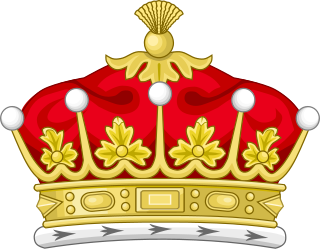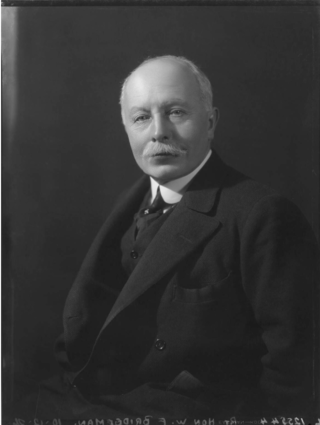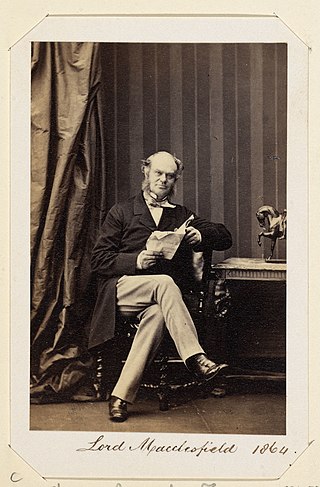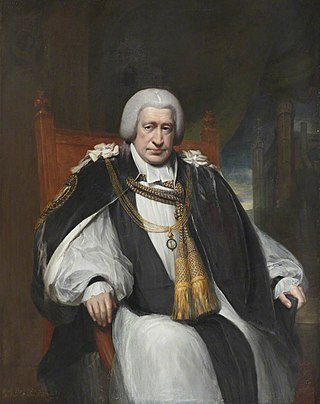
John William Ponsonby, 4th Earl of Bessborough, PC, known as Viscount Duncannon from 1793 to 1844, was a British Whig politician. He was notably Home Secretary in 1834 and served as Lord Lieutenant of Ireland between 1846 and 1847, the first years of the Great Famine.

Earl of the County of Mayo, usually known simply as Earl of Mayo, is a title in the Peerage of Ireland created, in 1785, for John Bourke, 1st Viscount Mayo. For many years he served as "First Commissioner of Revenue" in Ireland. He had already been created Baron Naas, of Naas in the county of Kildare, in 1776, and Viscount Mayo, of Moneycrower in the county of Mayo, in 1781, also in the Peerage of Ireland.

William Clive Bridgeman, 1st Viscount Bridgeman, PC, JP, DL was a British Conservative politician and peer. He notably served as Home Secretary between 1922 and 1924. He was also an active cricketer.

William Jacobson was Regius Professor of Divinity at Oxford University (1848–1865) and Bishop of Chester (1865–1884).

George Smith was a missionary in China and the Bishop of Victoria from 1849 to 1865, the first of this newly established diocese.
Brigadier The Honourable Geoffrey John Orlando Bridgeman MC, styled The Honourable from 1929, was a British soldier and ophthalmologist.

George Augustus Frederick Henry Bridgeman, 2nd Earl of Bradford, styled Hon. George Bridgeman from 1800–15 and Viscount Newport from 1815–25, was a British peer.
Brigadier-General Francis Charles Bridgeman JP, styled The Honourable from 1865, was a British Army officer and Conservative politician who sat in the House of Commons from 1885 to 1895.

The Honourable Richard Bagot was an English bishop.
Caroline Beatrix Bridgeman, Viscountess Bridgeman, DBE, JP was an English aristocrat, political activist, and churchwoman.

Sir Robert Henry Meade was a British civil servant and the Head of the Colonial Office between 1892 and 1897.
Thomas George Anson, 2nd Earl of Lichfield, known as Viscount Anson from 1831 to 1854, was a British politician from the Anson family.

Thomas Augustus Wolstenholme Parker, 6th Earl of Macclesfield was a British peer. Before inheriting the earldom, he sat in the House of Commons as Conservative Member of Parliament for Oxfordshire from 1837 until 1841.
Thomas Earle Welby was an English missionary, clergyman and former soldier. The younger son of a baronet, he served in the army for eight years, but, after leaving 1837, served as a missionary in Canada, where he became a rector, and later as an archdeacon in South Africa, before going on to be consecrated as the second bishop of the island Saint Helena in the Anglican church.

Brownlow North was a bishop of the Church of England.
The Rt Rev Wilfrid Parker was a Colonial Anglican bishop in the first half of the 20th century. He was born on 23 January 1883 son of the Hon. Cecil Thomas Parker and Rosamond Esther Harriett Longley. His grandfather on his father's side was Thomas Parker, 6th Earl of Macclesfield and his grandfather on his mother's side was Charles Longley, Archbishop of Canterbury. He was educated at St. Andrew's College, Grahamstown, Radley and Christ Church, Oxford. Ordained in 1907, his first post was as an Assistant Priest at the Christ Church Mission, Poplar. From 1909 to 1913 he was Domestic Chaplain to the Archbishop of York. Cosmo Lang was the Archbishop, and he and Parker developed a close friendship through regular newsy letters until the 1940s when Lang died. Lang's Chaplain in 1933 noted that Parker had a 'halo' as far as Lang, the Archbishop of Canterbury, was concerned. In June, 1916, Parker had been interviewed for a commission as a Temporary Chaplain to the Forces. At 6 feet 7 inches, he was exceptionally tall, he could ride and speak French, and was posted to Flanders where he was immediately involved in the Battle of the Somme. He was ill with trench fever from September, was hospitalised in England and was only fit to return to his duties in France early in 1917. He was then posted to Italy where he earned the Croce di Guerra, a bravery award. A report of December, 1918, referred to 'Very exceptional gifts as an Army Chaplain - good report When peace returned he became Vicar of St George's Johannesburg. From 1923 to 1931 he was Priest in Charge of the St Cyprian's Native Mission in the same city then Archdeacon and Director of Native Missions in the Diocese of Pretoria. He became Bishop of Pretoria in 1933 holding the post until his retirement in 1950. A Sub Prelate of the Order of Saint John of Jerusalem, he died on 23 June 1966.

Joseph Deane Bourke, 3rd Earl of Mayo was an Irish peer and cleric who held several high offices in the Church of Ireland including Bishop of Ferns and Leighlin (1772–82) and Archbishop of Tuam (1782–94).
Joseph Deane PC (1674–1715) was an Irish politician and judge who became Chief Baron of the Irish Exchequer. His sudden and premature death was popularly believed to be due to a chill caught when watching an eclipse of the sun.

Thomas Garnier the Younger was Dean of Lincoln from 1860 until his death in 1863.
Vice-Admiral Hon. Charles Orlando Bridgeman was a Royal Navy officer who saw active service in the Napoleonic Wars and the Greek War of Independence.














